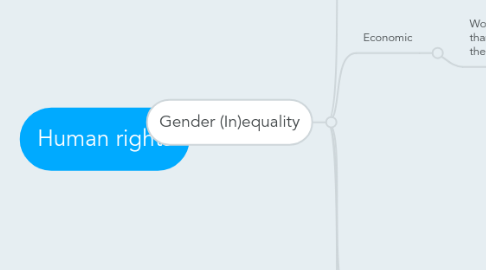
1. Gender (In)equality
1.1. Social
1.1.1. Women are viewed as second class citizens, talked about like an object (life of a woman). This should not be viewed as a "problem for developing counties" or that developed countries have already changed this "traditional" way of thinking or viewing women.
1.1.1.1. Developing: India's rape culture. The infamous case of 2012 New Delhi Gang Rape that shocked the world.
1.1.1.2. Developed: 1 in 3 women in USA are likely to have been sexually harassed in their lifetime. (George Mason University Worldwide Sexual Assault Statistics 2005) "Even if life begins in that horrible situation that is rape, that is something that God intended to happen" - Richard Mourdock. "If it is legitimate rape, the female body has ways to try to shut that whole thing down." - Todd Akin. JUST BULLSHIT.
1.1.1.3. HeForShe - Emma Watson UN Speech 2014. Calls on men to join the fight for gender equality. Since 20th September, more than 180000 men have "signed up" for this campaign- shows the effective use of social media to bring forth certain movements. A 15- year old boy, Ed Holtom, wrote a letter to The Telegraph, expressing his views on HeForShe, stating that it takes more than equal opportunities, it takes change, in our society, in our language. That we should not let gender define us.
1.1.1.3.1. Backlash: Misogynistic users continue to threaten Emma Watson over her UN speech. 4chan user labelled feminism as :growing cancer"
1.2. Economic
1.2.1. Women may not have the same opportunities than men due to the bias (unconscious or not) in the work place.
1.2.1.1. Based on a survey by Times, women, even in the 21st century, still only make 77 cents to a man's dollar. Why do women still earn less than men? Even in female dominated job areas, women still earn less (83.4%) than men according to the Census Bureau 2007
1.2.1.2. Since the feminist movement of the 1960s, women have become far more economically independent and socially autonomous, representing 42% of the UK workforce and 55% of university graduates. Yet women are still less likely than men to be associated with leadership positions in the UK: they account for 22% of MPs and peers, 20% of university professors, 6.1% of FTSE 100 executive positions, and 3% of board chairpersons.
1.2.1.3. Despite this, we can see that there has been a dramatic shift in traditional family dynamics and greater recognition of gender in legislative politics. Obama's Paycheck Fairness Act - to target underlying gender discrimination. Reports say 9 in 10 people want to see men and women equally represented in leadership positions: so the intention to change is there, but what about the social and political frameworks to support this change? (WAGE GAP)
1.3. Education
1.3.1. Women's right to education has been a widely discussed topic, however little have been done to address the causes of gender inequality in education
1.3.1.1. Malala Yousafzai, recent Nobel Peace Prize winner, believed in women's inherent right to education. Living under a Taliban's rule in Pakistan where girls were banned from attending school. UN petition "I am Malala" aimed to outlaw gender discrimination in schools and that all out-of-school children are in education by 2015.
1.3.1.2. 40% less women in STEM fields (Science, Tech, Engineering, Medicine). According to Forbes, A 2011 report by the U.S. Department of Commerce found only one in seven engineers is female. Additionally, women have seen no employment growth in STEM jobs since 2000. Many suspect that in our education system, girls are rarely encouraged to pursue jobs in STEM fields, as it was seen to be more of a "male" field while humanities and arts are "female" fields. (GENDER GAP)
1.4. Political
1.4.1. In politics, women continue to be under-represented
1.4.1.1. Only 21.8 per cent of national parliamentarians were female as of 1 July 2014, a slow increase from 11.3 per cent in 1995 - UN Women. (GENDER GAP) Examples: Angela Merkel- Germany Chancellor. Hilary Clinton - USA. Hilary Clinton and Sarah Palin's candidacies "left 18 million cracks on the highest, hardest glass ceiling, turns out women aren't finished yet; we can shatter the glass ceiling once and for all. Opposition leader (National League for Democracy) Aung San Suu Kyi.
1.4.1.2. Self perceptions - men remain almost 60 percent more likely than women to assess themselves as “very qualified” to run for office. Women in the sample are more than twice as likely as men to rate themselves as “not at all qualified.”
1.5. Media
1.5.1. Women are over-sexualised in media/ portrayed as products to sell.
1.5.1.1. But we do think it is problematic when nearly all images of women depict them not simply as 'sexy women' but as passive objects for someone else's sexual pleasure. "Sexualized portrayals of women have been found to legitimize or exacerbate violence against women and girls, as well as sexual harassment and anti-women attitudes among men and boys," Hatton says. "Such images also have been shown to increase rates of body dissatisfaction and/or eating disorders among men, women and girls - See more at: http://www.buffalo.edu/news/releases/2011/08/12769.html#sthash.sCDTEPrh.dpuf

